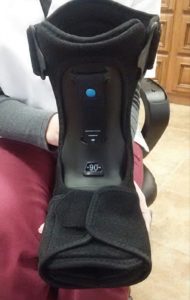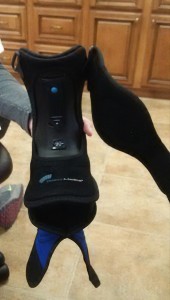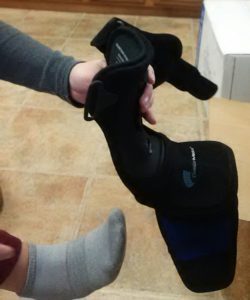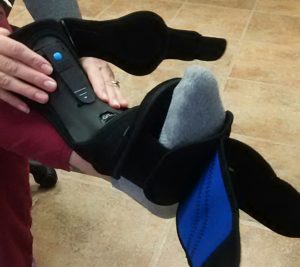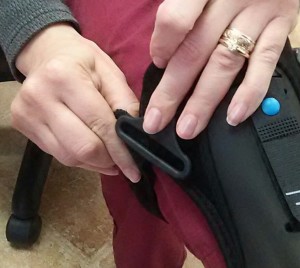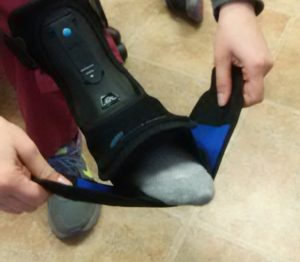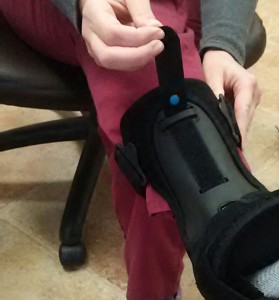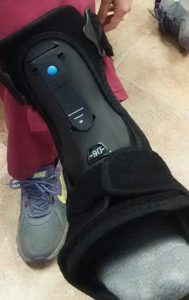Night Splints – Do they work for Heel Pain?
You just went to the foot doctor for heel pain and left with night splints in your hand. You might be thinking, “Does that night splint really work?” The answer to that is a resounding, “Yes!” and here is why.
Where does heel pain come from?
Most heel pain is from either Plantar fasciitis, also known as a heel spur, or Achilles Tendinitis, inflammation of the tendon in the back of the heel.
Plantar fasciitis is caused by overuse of the ligament that supports your arch. It can come from walking or standing more than usual, beginning a new exercise routine, starting a new sport, or even a new job that requires you to be on your feet a long time. This in turn causes inflammation which leads to pain.
Achilles tendinitis is from overuse or irritation to the tendon in the back of the heel. Achilles tendinitis can come from not warming up properly before an activity, not stretching before running, or even just wearing a new pair of shoes or boots.
The plantar fascia and Achilles tendon can tighten up a lot while you sleep. Then, when you first get up in the morning, they are so tight that it can be very painful to put weight on your foot. After a while, the ligament or tendon stretches out and may feel a little better. The pain can return later in the day when you have been on your foot a lot, or when the ligament or tendon tightens up again.
Night Splints – Why they work
Night splints help to keep the ligament or tendon stretched out, avoiding that sharp pain which keeps those structures inflamed.
Night splints stretch much better than manual stretching because they provide a steady, constant stretch. Manual stretching is usually performed for a few seconds to a minute or so. Night splints are usually worn for several hours giving you a good, even, steady stretch, which works much better.
Night Splints are covered by most insurance
Night splints are a proven treatment that help relieve heel pain. Most every insurance company will cover some or all of the cost of Night Splints.
What other treatments are used for heel pain?
The most common conservative treatments for plantar fasciitis and Achilles tendinitis are:
- Anti inflammatory medications
- Injection therapy
- Night splints
- Prescription orthotics
- Physical therapy
Conservative treatment relieves plantar fasciitis and Achilles tendinitis about 90% of the time. Occasionally, surgery is required.
Night Splints – which one works best
Dr. David Schlam, podiatrist Wappingers Falls NY, recommends a dorsal night splint, which has comfortable padding and less bulk than traditional night splints.
Dr. Schlam recommends using a night splint at home to help relieve the pain between doctors visits. The night splint is used to provide constant stretching, which is more effective than daily stretching. The stretching at night helps to reduce to stress and pain for your first step out of bed in the morning.
Night Splints – how to apply
Below is a step by step guide on the proper way to put on the dorsal night splint:
What if I can’t sleep with a Night Splint?
Maybe you are one of those people who is a light sleeper and just can’t get used to wearing night splints at bedtime. Here is another option for you.
You can wear a night splint while you are sitting watching TV, or are on the computer, or even reading a book. For maximum benefit, you should wear a night splint as much as possible. Some people find it easier to start wearing it while they are awake. When they get used to it while awake, you may find it easier to ease into to wearing it while sleeping. It may take a little while to get used to it, but in the long run, the relief that you get from wearing night splints is worth it!
At Hollowbrook Foot Specialist we are here to help. If you have any questions on how to use night splints properly or would like to be fitted with a night splint, give our office a call at (845) 298-9074.
Hollowbrook Foot Specialist – serving the Hudson Valley from Wappingers Falls.
by David Schlam


